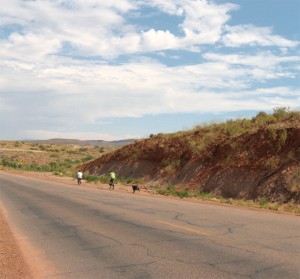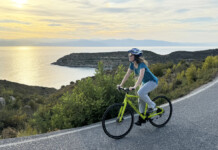
By Wayne Cottrell, From the Fall/Winter 2011 Issue
The Beaver Dam Mountains Classic is a 66.9-mile, out-and-back ride through mountainous and desert terrain. The ride starts in Santa Clara, ascends the Beaver Dam Mountains in extreme southwestern Utah, and then descends through an increasingly barren landscape, crossing into Arizona before entering the settlement of Beaver Dam. The return route reverses the outbound route. The elevation ranges from 1,880 feet in Beaver Dam, Arizona, to 4,721 feet at the crest of “Utah Hill,” in the Beaver Dam Mountains. The elevation in Beaver Dam, Arizona, is lower than Utah’s lowest elevation, and is the lowest altitude reached by any course in Road Biking Utah. The region is typically dry, hot, and windy, especially during the summer months, so be sure to bring plenty of fluids. Water can be replenished at the Dam Store or Dam Deli at the turnaround; otherwise, be self-sufficient.
The Beaver Dam Mountains are located in the extreme southwest corner of Utah, straddling the border between Utah and Arizona. The mountains are a collection of contrasts, at times jagged and at other times gently sloping; at times populated with trees and scrub and at other times barren. Also, despite the peak elevation of 7,680 feet (West Mountain), the region immediately adjacent the mountains includes Utah’s lowest elevated land. Regarding the trees, a large sector of the mountains is designated as the Joshua Tree Natural Wilderness Area. The Joshua Tree is of the yucca genus, and is found almost exclusively in the Mojave Desert. The name was concocted by Mormons who crossed the Mojave during the nineteenth century; the unusual shape of the tree reminded them of a biblical story in which Joshua reaches his hands up to the sun. The tree is known for its heavy branches, slow growth, and longevity. Animals indigenous to the Beaver Dam Mountains area include bighorn sheep, desert tortoise, raptors, and lizards.
Start at Santa Clara City Park (also referred to as Canyon View Park), at 1400 Canyon View Drive in Santa Clara (adjacent the Spencer Gunn Memorial Fields). Santa Clara is located to the west of St. George, in southwestern Utah. The terrain is mountainous, with one long climb and descent outbound, followed by the same inbound. To get there from I-15, head west on St. George Boulevard to Bluff Street. Turn right onto Bluff Street, then left onto Sunset Boulevard. Head west on Sunset Boulevard to Canyon View Drive. Turn right onto Canyon View Drive; look for the City Park on the right, just beyond the high school signs.
Santa Clara, a suburb of St. George, had a population of 6,866 in 2008. The city is named after the river that flows through the city on its course from the Pine Valley Mountains to the Virgin River. The name also refers to the region’s good weather. Head south on Canyon View Drive to Santa Clara Drive. Turn right at the traffic signal. Enter the Santa Clara Historic District at mile 0.8. There are a number of historic buildings along Santa Clara Drive, including the George and Bertha Graff House at 2865 Santa Clara Drive, the Frederick and Anna Maria Reber House at 2988–2990 Santa Clara Drive, the Hans George Hafen House at 3003 Santa Clara Drive, the Santa Clara Relief Society House at 3036 Santa Clara Drive, the Santa Clara Tithing Company at 3105 Santa Clara Drive, and the Frederick and Mary F. Reber House at 3334 Santa Clara Drive. Also, the Jacob Hamblin House (the Mormon missionary) is just off Santa Clara Drive, near the western end of the district.
The road curves right at mile 1.8, leaving the historic district. Begin climbing at mile 2.0. The gradient eases at mile 2.8, although the road continues uphill. Note the reddish color of the ground in this area. The imposing mountains on the right are named the Red Mountains. The highway traverses the western edge of Ivins starting around mile 3.9. There is a short descent at mile 4.8, followed by rollers. Enter the Shivwits Paiute Reservation at mile 6.4. The highway crests at mile 7.5, followed by a descent to a crossing of the Santa Clara River. Beyond the crossing, the highway starts to wind and climb. Stay left at the junction at mile 9.3, toward Old Highway 91. You are now following the Old Spanish Trail. Note the red rocks on the surrounding hillsides (“red rocks” is a theme heard and seen repeatedly throughout Utah). The highway continues to roll upward through this landscape; there are several false crests, and the roadway width varies between two and three lanes to accommodate climbing segments. Enter the Beaver Dam Mountains at mile 13.2—from here, the hillsides “close in” on the highway as it winds toward the summit. During my field visit in July 2008, most of the surrounding trees were blackened, as evidence of a recent wildfire. Exit the Shivwits Paiute Reservation at mile 15.2. The trees and desert scrub become denser around mile 16.4, an indicator of the higher elevation. The highway crests at mile 16.9; a long descent begins here.
 The passage through the Beaver Dam Mountains is along Old Highway 91, a north-south route that formerly stretched from California to Canada. Although portions of the highway currently exist—designated as US 91—most of the older segments have been replaced by I-15. The route through the mountains also follows the Old Spanish Trail, used in the early nineteenth century to connect Santa Fe, New Mexico (which was then part of Mexico), with Los Angeles, California. The route avoided the extremes of the Mojave Desert and established a trade route between the United States and Mexico.
The passage through the Beaver Dam Mountains is along Old Highway 91, a north-south route that formerly stretched from California to Canada. Although portions of the highway currently exist—designated as US 91—most of the older segments have been replaced by I-15. The route through the mountains also follows the Old Spanish Trail, used in the early nineteenth century to connect Santa Fe, New Mexico (which was then part of Mexico), with Los Angeles, California. The route avoided the extremes of the Mojave Desert and established a trade route between the United States and Mexico.
The landscape becomes increasingly barren around mile 19.3. The vista is wide and encompassing. The mountains in the far distance include Bunkerville Ridge and the Black Rock and Virgin ranges. The floor of the Virgin Valley can be seen clearly below; the highway eventually takes you there. Enter the Joshua Trees Wilderness Area around mile 20.7. These protected yucca trees have an unusual shape—nearly all branches, with very little trunk. The trees can survive the harsh desert environment, provided that there is some rainfall and at least one winter freeze. The trees are pollinated entirely by the yucca moth. Enter Arizona at mile 26.2; you are now in Mohave County, on CR 91. The downhill gradient eases at mile 28.4. After a long, straight segment, the highway finally bends right at mile 31.6. Enter the Beaver Dam settlement at mile 32.2. The I-15 freeway is less than 2 miles from here. Beaver Dam, and the immediately adjacent Littlefield settlement, are located about 10 miles from the booming border town of Mesquite, Nevada. Turn around at Old Pioneer Road, just past the bridge over Beaver Dam Wash, adjacent the Dam Store. Note that the Dam Deli and Dam Bar are next door, making this a dam good place to turn around and restock on fluids. (Please consult Road Biking Utah for a description of the return ride, and for further historic details about the route).
Excerpted from Road Biking Utah (Falcon Guides), written by avid cyclist Wayne Cottrell. Road Biking Utah features descriptions of 40 road bike rides in Utah. The ride lengths range from 14 to 106 miles, and the book’s coverage is statewide: from Wendover to Vernal, and from Bear Lake to St. George to Bluff. Each ride description features information about the suggested start-finish location, length, mileposts, terrain, traffic conditions and, most importantly, sights. The text is rich in detail about each route, including history, folklore, flora, fauna and, of course, scenery.
Wayne Cottrell is a former Utah resident who conducted extensive research while living here – and even after moving – to develop the content for the book.








